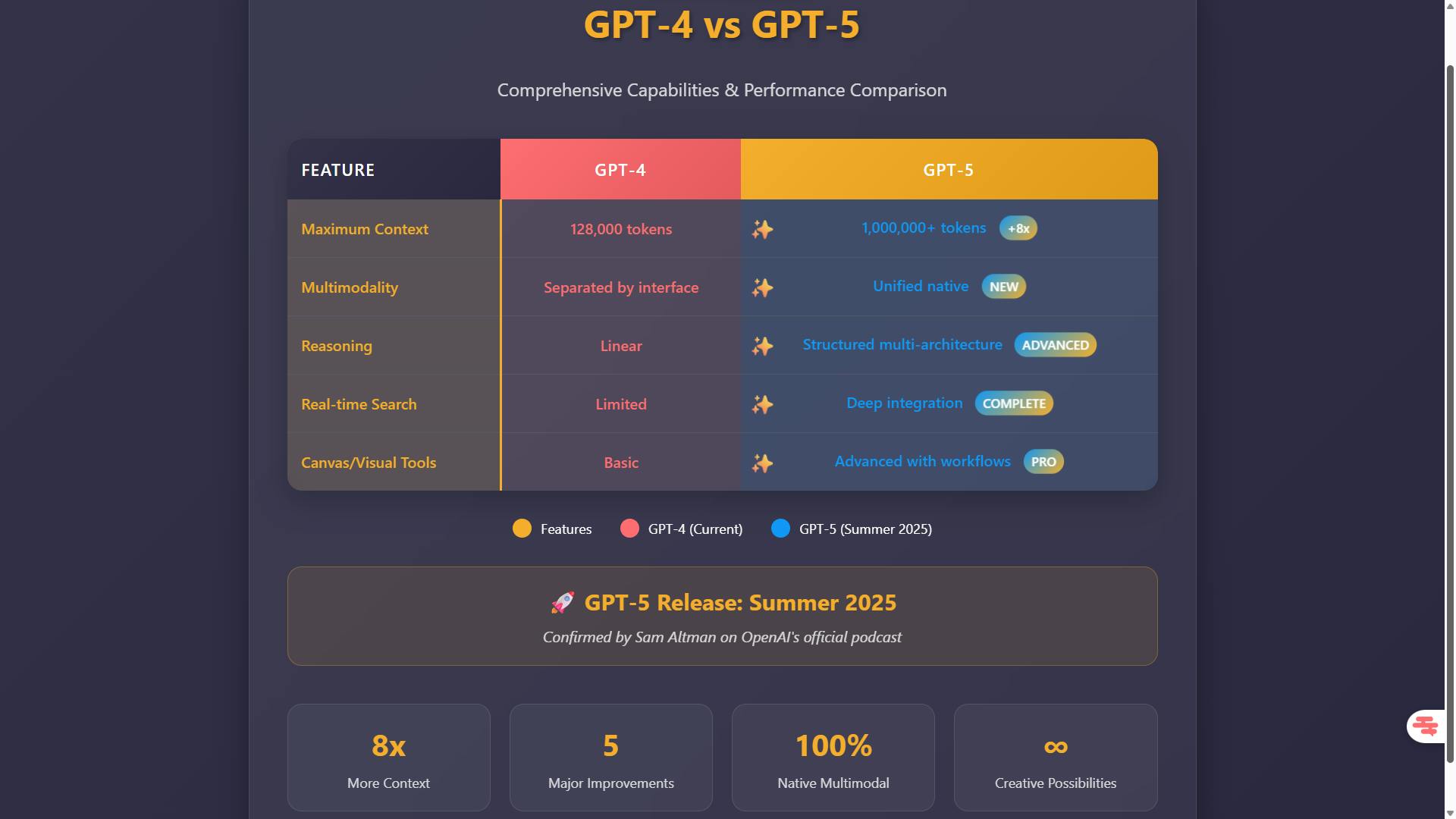Table of contents :
GPT-5 Summer 2025 Release: OpenAI Finally Unveils Its New AI
The wait is finally over: GPT-5 will officially launch during summer 2025. Sam Altman, CEO of OpenAI, confirmed this information during the first episode of the company's official podcast, ending months of speculation. This announcement marks a major turning point in the evolution of conversational artificial intelligence.
OpenAI Confirms GPT-5's Imminent Release
A Subtle Announcement with Major Consequences
Unlike previous launches accompanied by major marketing campaigns, GPT-5's announcement was made subtly. Sam Altman simply dropped the information during a podcast conversation, confirming a release window between June and September 2025.
This minimalist approach hides considerable stakes. GPT-5 represents the next step in the race toward artificial general intelligence (AGI), with capabilities that could redefine our interaction with machines.
Timeline and Deployment Strategy
Confirmed release period: Summer 2025 (July-August likely) Testing phase: Ongoing, with focus on security and robustness Deployment: Gradual, as with previous versions
OpenAI maintains its tradition of meticulous refinement before each launch. AI safety teams are currently working on final adjustments to ensure risk-free deployment.

GPT-5 New Features: The Game-Changing Capabilities
Advanced Reasoning and Hybrid Architecture
GPT-5 integrates multiple reasoning architectures, notably the structured approach developed with the o3 model. This evolution enables:
- Enhanced logical analysis for complex problems
- Step-by-step resolution of mathematical and scientific challenges
- Argumentative coherence over long reasoning chains
This improvement directly addresses current GPT-4 limitations in pure logic and multi-step problem solving.
Unified Multimodality: Text, Image, Audio, Video
One of GPT-5's most anticipated innovations concerns native multimodal integration. Unlike GPT-4 which processes each content type separately, GPT-5 will offer:
Unified processing:
- Simultaneous text + image + audio analysis
- Cross-modal content generation
- Contextual understanding between different media
SORA Integration:
- Native video capabilities
- Visual sequence generation and analysis
- Complex multimedia content creation
Extended Context: Beyond One Million Tokens
GPT-5 breaks a major technical barrier with extended context exceeding 1 million tokens, equivalent to:
- 10+ complete books in active memory
- Multi-threaded conversations with complete history
- Long-term projects with perfect continuity
This expansion finally allows working on complex projects without context loss, revolutionizing professional AI usage.
ChatGPT 5 vs GPT-4: Performance Comparison
Capability Comparison TableFeatureGPT-4GPT-5Maximum context128,000 tokens1,000,000+ tokensMultimodalitySeparated by interfaceUnified nativeReasoningLinearStructured multi-architectureReal-time searchLimitedDeep integrationCanvas/Visual toolsBasicAdvanced with workflows

Concrete Improvements for Users
Code Professionals:
- Multi-file projects with complete context
- Advanced debugging on extended codebases
- Complex software architecture
Content Creators:
- Coherent multimedia campaigns
- Cross-platform storytelling
- Automatic adaptation to different formats
Researchers and Analysts:
- Synthesis of voluminous documentation
- Correlations between multiple sources
- In-depth reports with real-time sources
Canvas Integration and Visual Workflows
The Reinvented Canvas Tool
Canvas becomes the heart of the GPT-5 experience, offering:
Advanced visual interface:
- Direct element manipulation
- Visualized step-by-step workflows
- Intuitive human-machine collaboration
Specialized applications:
- Mathematics: Visual resolution of complex equations
- Programming: Interactive code architecture
- Design: AI-assisted prototyping
This evolution transforms GPT-5 from a simple chatbot into a true collaborative work environment.
Real-Time Search and Updated Data
Deep Web Integration
GPT-5 revolutionizes information access with:
Intelligent retrieval:
- Multiple sources analyzed simultaneously
- Automatic cross-verification
- Real-time comparative synthesis
Practical applications:
- Automated competitive intelligence
- Updated trend analysis
- In-depth academic research
This capability eliminates the "knowledge cutoff" problem that limited previous versions.
Business Model and Advertising: OpenAI's Position
Sam Altman Draws Red Lines
Regarding monetization, Sam Altman was categorical about limits not to cross:
Acceptable advertising:
- Clearly identified peripheral inserts
- External banners to responses
- Useful and contextual suggestions
Prohibited advertising:
- Manipulation of responses by advertisers
- Sponsored content integrated into reasoning
- Commercial bias in analyses
This approach aims to preserve user trust, a crucial element for GPT-5's mass adoption.
Impact on AI Ecosystem and Competition
Expected Competitor Reactions
Google Gemini will need to accelerate its multimodal developments Anthropic Claude bets on security as a differentiator Microsoft Copilot will benefit from OpenAI integration
Implications for Developers
GPT-5 API will open new possibilities:
- Native multimodal applications
- Sector-specialized assistants
- Advanced enterprise integrations
Frequently Asked Questions about GPT-5
When will GPT-5 be available exactly?
GPT-5 will be released during summer 2025, probably between July and August. OpenAI is currently finalizing security tests before the official launch.
Will GPT-5 be free like GPT-4?
A free tier will probably exist, but advanced features (extended context, complete multimodality) will require a premium subscription.
What are the main improvements over GPT-4?
Major improvements include: 8x larger context, unified multimodality, structured reasoning, and real-time web integration.
Will GPT-5 completely replace GPT-4?
GPT-4 will remain available for applications requiring fewer resources. GPT-5 will target advanced and professional uses.
Preparation and Recommendations
For Businesses
Evaluate your current needs:
- Identify GPT-4 limitations in your workflows
- Plan progressive migration to GPT-5
- Train your teams on new capabilities
Anticipate opportunities:
- New products based on multimodality
- Complex process automation
- Customer experience improvement
For Developers
Prepare technically:
- Study preliminary API documentation
- Design modular architectures
- Plan integration tests
GPT-5, the AI that Redefines Possibilities
GPT-5 represents much more than a simple update: it's a qualitative leap toward truly versatile artificial intelligence. With its planned summer 2025 release, OpenAI is preparing to redefine conversational AI standards.
The major innovations - extended context, unified multimodality, advanced reasoning - open unprecedented perspectives for professionals and the general public alike. It remains to observe how this new generation of AI will concretely transform our ways of working and creating.
Will summer 2025 mark the beginning of a new era for artificial intelligence? All indicators point in this direction.
author
OSNI

Published
June 26, 2025